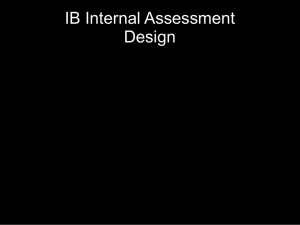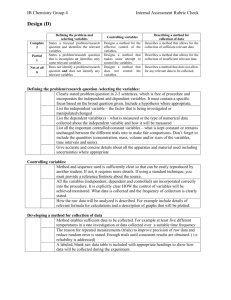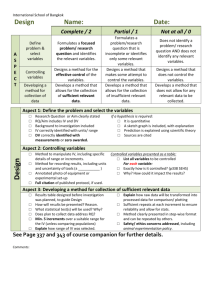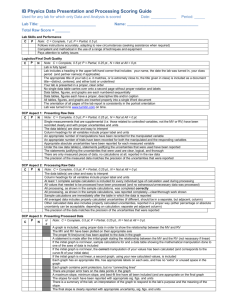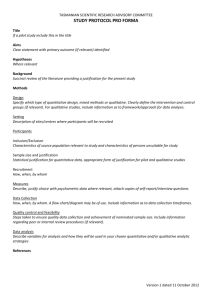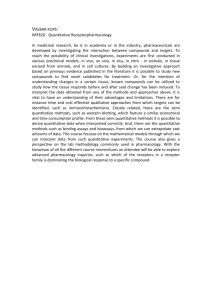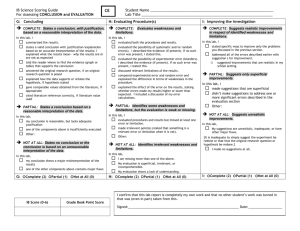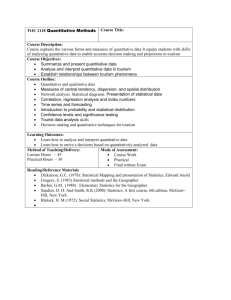Demonstrating Osmosis in Potato
advertisement
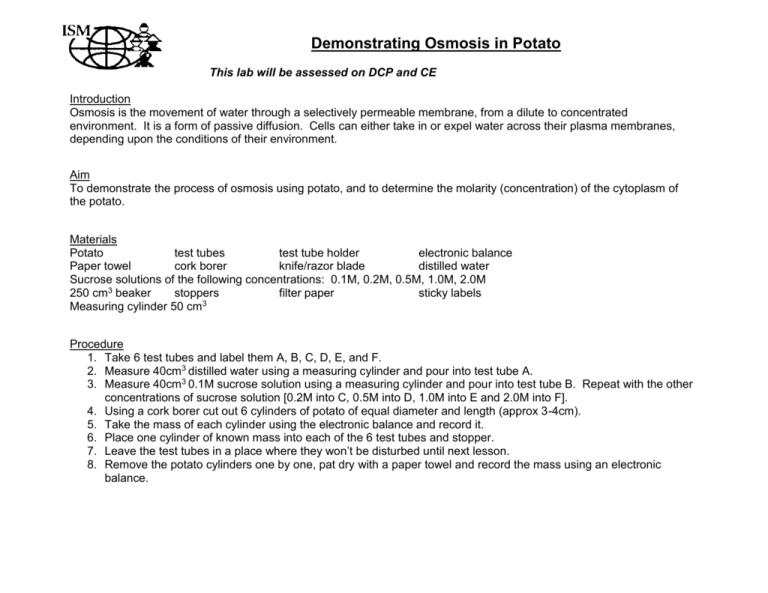
Demonstrating Osmosis in Potato This lab will be assessed on DCP and CE Introduction Osmosis is the movement of water through a selectively permeable membrane, from a dilute to concentrated environment. It is a form of passive diffusion. Cells can either take in or expel water across their plasma membranes, depending upon the conditions of their environment. Aim To demonstrate the process of osmosis using potato, and to determine the molarity (concentration) of the cytoplasm of the potato. Materials Potato test tubes test tube holder electronic balance Paper towel cork borer knife/razor blade distilled water Sucrose solutions of the following concentrations: 0.1M, 0.2M, 0.5M, 1.0M, 2.0M 250 cm3 beaker stoppers filter paper sticky labels 3 Measuring cylinder 50 cm Procedure 1. Take 6 test tubes and label them A, B, C, D, E, and F. 2. Measure 40cm3 distilled water using a measuring cylinder and pour into test tube A. 3. Measure 40cm3 0.1M sucrose solution using a measuring cylinder and pour into test tube B. Repeat with the other concentrations of sucrose solution [0.2M into C, 0.5M into D, 1.0M into E and 2.0M into F]. 4. Using a cork borer cut out 6 cylinders of potato of equal diameter and length (approx 3-4cm). 5. Take the mass of each cylinder using the electronic balance and record it. 6. Place one cylinder of known mass into each of the 6 test tubes and stopper. 7. Leave the test tubes in a place where they won’t be disturbed until next lesson. 8. Remove the potato cylinders one by one, pat dry with a paper towel and record the mass using an electronic balance. TASKS: Hypothesis Write a hypothesis for what you expect to find in this experiment. Cite any sources you use. Data Collection and Processing Record your raw data in a suitable format, including units and uncertainties. Process your raw data and present it appropriately, taking into account errors and uncertainties. Conclusion and Evaluation State a conclusion, with justification, based on a reasonable interpretation of the data obtained. Evaluate weaknesses and limitations in the procedure. Suggest realistic improvements in respect of identified weaknesses and limitations. Data Collection and Presentation (IB rubric +) Levels – ISM (Levels – IB) ISM Mark IB Marks Aspect 1 Recording raw data (table) (descriptive title, descriptive column and row headers, units, uncertainties, decimal placing, significant figures.) Raw data measured as precisely as possible; recorded with same number of digits after decimal; uncertainties quantified Raw data recorded in a tidy, organized and properly titled table1 [original data collection sheet was attached to report] If applicable: diagrams drawn with straight, non-intersecting lines that terminate exactly at the item being labeled Aspect 2 Processing raw data (selection of process, explanation of processing as though to a non scientist) All calculations were correct; example calculations were provided (e.g. mean, standard deviation, Chi-square, etc.) All the stages - from raw data to final graph – are presented and can be followed easily Aspect 3 Presenting processed Data (graph) Processed data first presented in tidy, organized and properly titled table(s); exactly two digits after each decimal Processed data then presented in a graph that clearly shows trends and allows for easy interpretation Graph(s) indicated uncertainty with ‘line of best fit’ or error bars (+/- one standard deviation) Multiple treatments appeared on same graph for easy interpretation Each axis was labeled properly with the correct units (independent variable on x-axis; dependent variable on y-axis) Graph titles were complete: included dependent and independent variables [and species name(s) if applicable] Avoided unnecessary cosmetic features 1 Exemplary (Complete) 4 2 Records appropriate quantitative and associated qualitative raw data, including correct SI units and uncertainties where relevant. Proficient (Partial + ) 3 1 Records appropriate quantitative and associated qualitative raw data, including all units and most uncertainties where relevant. Misses 1 or 2 uncertainties. Processes all the quantitative raw data correctly. Processes most of the quantitative raw data correctly. (Explains all of processing clearly.) (Explains most of processing clearly.) Presents all processed data appropriately and, where relevant, includes errors and uncertainties. Presents most processed data appropriately and, where relevant, includes units and uncertainties on axes. (Error bars present but erroneous) Developing (Partial) 2 1 Records appropriate quantitative and associated qualitative raw data, but with some mistakes or omissions. (Decimal placing error, significant figure error, SI unit error) Processes quantitative raw data, but with some mistakes or omissions. (Limited explanation of processing.) Emerging (Partial - ) 1 1 Records appropriate quantitative and associated qualitative raw data in appropriate form without units or uncertainties. Not present (Not at all) 0 0 Does not record any appropriate quantitative raw data or raw data is incomprehensible. (Table is difficult to interpret.) Processes quantitative raw data, but with some mistakes and some omissions. (Confused and limited explanation of processing) No processing of quantitative raw data is carried out or major mistakes are made in processing. (No explanation of processing) Presents processed data appropriately, but with some mistakes and/or omissions. (Error bars absent.) Presents processed data in a comprehensible format, (omits units or title is not descriptive. Axes may be switched) Presents processed data inappropriately or incomprehensibly. A table title is numbered and it contains the dependent and independent variables: e.g. Table 1: Volume of O 2 released from potato puree solutions (250ml) at different temperatures (5, 10, 15, 20, 25, 30, 35 oC) following the addition of catalase and H2O2. Each column header contains the units in brackets: e.g. O2 released (ml/min). The units do not repeat in each row of a column. Concluding and evaluating (IB rubric +) Levels – ISM (Levels – IB) Exemplary (Complete) Proficient (Partial + ) Developing (Partial) Emerging (Partial - ) Not present (Not at all) ISM Mark IB Marks 4 2 States a valid conclusion, with justification, based on a reasonable interpretation of the data. (Compares value or result with literature value.) 3 1 States a valid conclusion, with weak justification, based on a reasonable interpretation of the data. 2 1 States a valid conclusion based on a reasonable interpretation of the data without justification. 1 1 States a valid conclusion to explain some limited parts of the data without justification. 0 0 States no conclusion or the conclusion is based on an unreasonable interpretation of the data. Evaluates weaknesses and limitations. (how big are the problems? – quantified)) Identifies weaknesses and limitations. (how big are the problems – qualified) Identifies some weaknesses and limitations, but the evaluation is weak or missing. Identifies some weaknesses or limitations, but the evaluation is weak or missing. Identifies irrelevant weaknesses and limitations. Suggests realistic improvements in respect of all of identified weaknesses and limitations. Suggests realistic improvements in respect of most of identified weaknesses and limitations Suggests only Superficial improvements for most of identified limitations. Suggests some superficial improvements for some of the identified improvements Suggests unrealistic Improvements or Does not suggest improvements Aspect 1 - Concluding A valid conclusion was stated clearly as either supporting or not supporting the hypothesis [eg The data supported the hypothesis that] The conclusion was based on: trends in graphs; or comparisons of different graphs; or comparisons of different lines in the same graph If applicable, the result was compared with a textbook/internet source to draw a conclusion about the reliability of the data Aspect 2 - Evaluating Sources of error were identified, and for each it was explained how significantly the error impacts on the reliability of the data The precision and accuracy of measurements were commented upon with specific reference to the equipment used Procedural weaknesses stated with specific reference to: timemanagement, replication, controlled variables, levels of treatment Aspect 3 Improving the investigation (how can the experiment be made better) Realistic and specific suggestions were made to improve each procedural weakness that was identified
